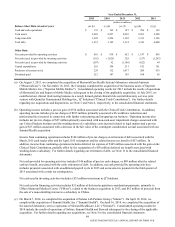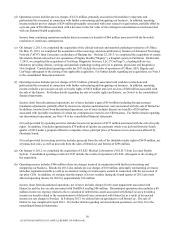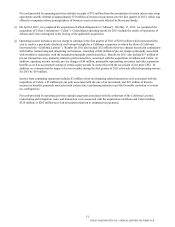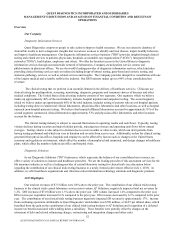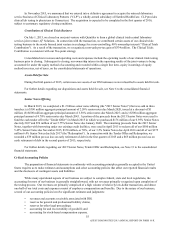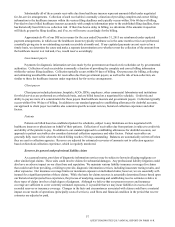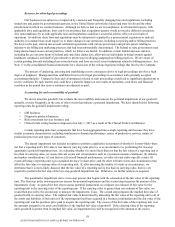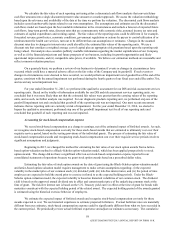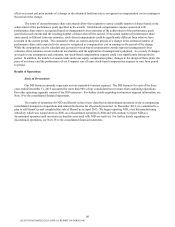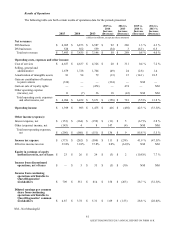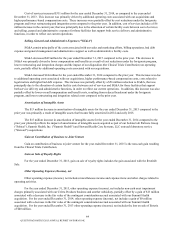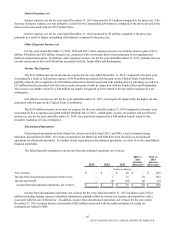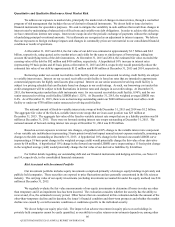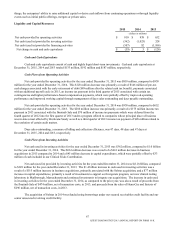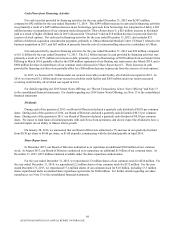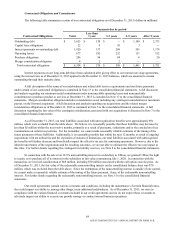Quest Diagnostics 2015 Annual Report Download - page 63
Download and view the complete annual report
Please find page 63 of the 2015 Quest Diagnostics annual report below. You can navigate through the pages in the report by either clicking on the pages listed below, or by using the keyword search tool below to find specific information within the annual report.59
We calculate the fair value of each reporting unit using either a discounted cash flows analysis that converts future
cash flow amounts into a single discounted present value amount or a market approach. We assess the valuation methodology
based upon the relevance and availability of the data at the time we perform the valuation. The discounted cash flows analysis
includes several unobservable inputs related to our own assumptions. The assumptions and estimates used in the discounted
cash flows model are based upon the best available information in the circumstances and include a forecast of expected future
cash flows, long-term growth rates, discount rates that are commensurate with economic risks, assumed income tax rates and
estimates of capital expenditures and working capital. The fair values of the reporting units could be different if, for example,
forecasted revenue growth rates, economic conditions, government regulations or actions by payers to control utilization of or
reimbursement for health care services, turn out to be different than our assumptions or estimates. Changes in the assumed
discount rates due to changes in interest rates could also affect the estimated fair values of the reporting units. We use a
discount rate that considers a weighted average cost of capital plus an appropriate risk premium based upon the reporting unit
being valued. Our analysis also considers publicly available information regarding the market capitalization of our Company,
as well as (i) the financial projections and future prospects of our business, including its growth opportunities and likely
operational improvements, and (ii) comparable sales prices, if available. We believe our estimation methods are reasonable and
reflect common valuation practices.
On a quarterly basis, we perform a review of our business to determine if events or changes in circumstances have
occurred which could have a material adverse effect on the fair value of the Company and its goodwill. If such events or
changes in circumstances were deemed to have occurred, we would perform an impairment test of goodwill as of the end of the
quarter, consistent with the annual impairment test performed during the fourth quarter of our fiscal year ended December 31st,
and record any noted impairment loss.
For year ended December 31, 2015, we performed the qualitative assessment for our DIS and risk assessment services
reporting units. Based on the totality of information available for our DIS and risk assessment services reporting units, we
concluded that it was more likely than not that the estimated fair values were greater than the carrying values of the reporting
units, and as such, no further analysis was required. For our diagnostic products reporting unit, we performed step one of the
goodwill impairment test and concluded that goodwill of the reporting unit was not impaired. Our most recent assessment
indicates that no reporting units are currently at risk of impairment. For the year ended December 31, 2014, we elected to
bypass the qualitative assessment, performed step one of the goodwill impairment test for all of our reporting units and
concluded that goodwill of each reporting unit was not impaired.
Accounting for stock-based compensation expense
We record stock-based compensation as a charge to earnings, net of the estimated impact of forfeited awards. As such,
we recognize stock-based compensation cost only for those stock-based awards that are estimated to ultimately vest over their
requisite service period, based on the vesting provisions of the individual grants. The process of estimating the fair value of
stock-based compensation awards and recognizing stock-based compensation cost over their requisite service periods involves
significant assumptions and judgments.
Beginning in 2015, we changed the method for estimating the fair value of our stock option awards from a lattice-
based option-valuation method to a Black-Scholes option-valuation model, which has been applied prospectively to stock
option awards. The change did not have a significant effect on our stock-based compensation expense reported in our
consolidated statements of operations because we grant stock option awards based on a prescribed dollar value.
Estimating the fair value of stock option awards on the date of grant using the Black-Scholes option-valuation model
and lattice-based option-valuation model requires management to make certain assumptions regarding: (i) the expected
volatility in the market price of our common stock; (ii) dividend yield; (iii) risk-free interest rates; and (iv) the period of time
employees are expected to hold the award prior to exercise (referred to as the expected holding period). Under the Black-
Scholes option-valuation model, the expected volatility is based on historical volatilities of our common stock. The dividend
yield is based on the approved annual dividend rate in effect and current market price of the underlying common stock at the
time of grant. The risk-free interest rate is based on the U.S. Treasury yield curve in effect at the time of grant for bonds with
maturities consistent with the expected holding period of the related award. The expected holding period of the awards granted
is estimated using the historical exercise behavior of employees.
We estimate the expected impact of forfeited awards and recognize stock-based compensation cost only for those
awards expected to vest. We use historical experience to estimate projected forfeitures. If actual forfeiture rates are materially
different from our estimates, stock-based compensation expense could be significantly different from what we have recorded in
the current period. We periodically review actual forfeiture experience and adjust our estimates as necessary. The cumulative
QUEST DIAGNOSTICS 2015 ANNUAL REPORT ON FORM 10-K


